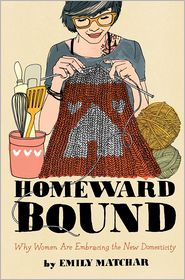

I just finished Homeward Bound: Why Women Are Embracing the New Domesticity by Emily Matcher. I think anyone (especially women) who dreams of being the next Pioneer Woman or other DIY-lifestyle/scrapbooking/crafty blogger extrordinaire should read this book. Matcher raises many critical questions about what this turn to domesticity means for women and society.
I don’t quite know where to begin with a review of the book because I have much of the book underlined and notes on numerous pages. I think I’ll just post my comments on the book as they come up through the book.
Chapter 1
While knitting as a craft and blogging about family gets its due in the book, scrapbooking does not. On page 13, Matcher writes
Though it may resemble your grandmother’s homemaking, it’s not–this is something new, different, perhaps even revolutionary.
Substitute the word scrapbooking for homemaking. During my interviews with scrapbookers, I heard all about how this wasn’t your grandma’s scrapbooking. Scrapbooking today is different. Yes, it is different. Today there is a whole industry supporting scrapbooking unlike during my grandmother’s time. I’ll admit that at times I’ve considered scrapbooking revolutionary. It allows people to write their own history–the history that gets left out of official accounts. But is this really revolutionary? I’m not so sure.
On page 15, Matcher outlines several factors influencing what she calls new domesticity. These are:
- A rising sense of distrust toward the government, corporations, and the food system.
- Concern for the environment.
- The gloomy economy.
- Discontent with contemporary work culture.
- The draw of hands-on work in a technology-driven world.
- An increasingly intensive standard of parenting.
How does this contrast with the growth of scrapbooking?
A rising sense of distrust toward the government, corporations, and the food system.
This didn’t exactly come up during my interviews with scrapbookers. But, several suggested that 9/11 caused an increase in the number of people scrapbooking. I’m not sure if 9/11 fits here or not, but am curious as to whether 9/11 as an explanation is being replaced with the above explanation.
Concern for the environment.
Concern for the environment holds a strange space in scrapbooking. On the one hand, many of us espouse the mantra of “use your stash,” yet at the same time many scrapbooker-bloggers would earn no income without selling products (whether scrapbooking or otherwise). EcoScrapbook and Almost Never Clever are the folks that come to mind when I think about people who consistently promote scrapbooking over products.
The gloomy economy.
If anything, the gloomy economy is blamed for scrapbook stores and manufacturers closing or filing for bankruptcy. I think these closures and bankruptcies are a bit more nuanced than that. I do think that part of the appeal of Project Life is its simplicity. I don’t need any tools to do it. I don’t even need adhesive to do Project Life. I don’t need any other embellishments to do it. I don’t have to buy lots of product “just in case I need it.” I can buy a kit once a year and be done. It’s just photos and paper making it potentially an affordable option for people. My oh my, I might be talking myself into giving it a go again…
Discontent with contemporary work culture.
Scrapbooking grew in popularity due in part to discontent with contemporary work culture. Creative Memories is a direct selling company. Direct selling companies have long held a place for women as a source of income while balancing family responsibilities (though I doubt that many make much money and those that do are working significantly more than they thought they would). Direct selling scrapbooking companies are still around and the today, we have a rise in scrapbooking-blogs. These too, offer the promise of an income while balancing family responsibilities. Again, the most successful tend to hire nannies and housekeepers to make it all work. And if I could just find a housecleaner that worked in the middle of nowhere, I’d have one, too.
The draw of hands-on work in a technology-driven world.
Yes, scrapbooking fits here–at least conventional scrapbooking (i.e., paper/non-digi) (go ahead and send the hate mail…). In my interviews, people talked about how they wanted to get their hands dirty or that scrapbooking was an escape from their computer-mediated work.
An increasingly intensive standard of parenting.
Hmmm….guilting moms into creating scrapbooks for their children has long been a feature of the scrapbook industry. Though my respondents by and large scrapbooked for themselves rather than for the kids even if the subject was her kids. Regardless, scrapbooking is way for people to demonstrate “good” motherhood even if that is not what is pushing them to scrapbook.
As I read the book, I thought a lot about the trade-offs. Baking my own bread is lovely and I do it during the summer, but what could I be doing instead? I could be writing. I could be teaching. I could be doing something that actually earns a wage. And no the money saved by baking bread is not a wage. Heck, I could even spend time with my child. 🙂 Considering scrapbooking, there are trade-offs, too. I am thinking about the time I spend post-processing photos. I don’t enjoy it. It is time consuming and for the most part, improves my photos only a bit. It delays me printing photos. I’ve begun limiting my post-processing to cropping photos. I could be scrapbooking instead. I could be creating new memories to scrapbook. And honestly, anyone who is going to judge me based on my photo quality and refusal to fully post-process isn’t worth my time.
I also think there needs to be a new rule in the (scrapbooking) blogosphere. If your blog is largely underwritten by a working spouse or other income of your own, then say so on your blog. Without this information, it just feeds the fantacies of people who want to make a living from their blog. Can people make a living from a blog or other web-based business? Sure they can, but we need more transparancy. It’s the responsible thing to do and certainly doesn’t make a person a failure or success either way.
Well that is enough for today. And in the interest of full-disclosure, I make very little money from this blog. The blog is mostly underwritten by my full-time job. I have yet to earn enough from this blog to cover hosting and my domain costs. Of course, I barely promote this blog and have limited advertising. If you click on the photo above of the book, it will take you to an affiliate link at Barnes and Noble. I do have to pay hosting afterall and live in a state where Amazon affiliates earn nothing. I’ll write more about the book at a later date. Maybe next week. In the meantime, do pick up Homeward Bound. It’s well worth your time.








 Stephanie Medley-Rath is a sociologist and scrapbooker who studies scrapbooking and memory keeping. Scrapworthy Lives is a blog focused on her sociological analysis of scrapbooking, with a sprinkling of posts about Stephanie's own scrapbooking projects.
Stephanie Medley-Rath is a sociologist and scrapbooker who studies scrapbooking and memory keeping. Scrapworthy Lives is a blog focused on her sociological analysis of scrapbooking, with a sprinkling of posts about Stephanie's own scrapbooking projects.
